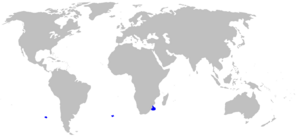Longnose pygmy shark facts for kids
Quick facts for kids Longnose pygmy shark |
|
|---|---|
| Conservation status | |
| Scientific classification | |
| Genus: |
Heteroscymnoides
|
| Species: |
marleyi
|
 |
|
| Range of the longnose pygmy shark | |
The longnose pygmy shark (Heteroscymnoides marleyi) is a super rare and tiny shark. It's the only shark of its kind in the Heteroscymnoides group. This small shark lives in the cold, open waters of the Southern Hemisphere. It can be found from the ocean surface down to about 502 meters (1,647 feet) deep.
This shark is usually dark brown and can grow up to 37 centimeters (15 inches) long. That's about the size of a ruler! It has a unique, long, rounded snout. It also has two fins on its back, called dorsal fins, that don't have spines. Scientists believe this shark is not in much danger from fishing. So, it's listed as "Least Concern" by conservation groups.
Contents
How This Shark Got Its Name
The longnose pygmy shark was first described by an American zoologist named Henry Weed Fowler. He wrote about it in 1934. His description was based on a small female shark, about 13 centimeters (5 inches) long. This shark was found near Durban, South Africa.
Fowler first thought this shark belonged to a different group. But then he realized it was unique. So, he created a new group, or genus, for it called Heteroscymnoides. This name comes from a Greek word meaning "resemblance." He named the shark marleyi to honor Harold Walter Bell-Marley. Harold helped a lot with studying fish in South Africa.
Where Longnose Pygmy Sharks Live
The longnose pygmy shark has been found in a few different places. These include the western Indian Ocean near eastern KwaZulu-Natal and the southeastern Atlantic Ocean. It has also been seen in the southwestern Pacific Ocean off Chile.
These sightings suggest that this shark might live all around the Southern Hemisphere. It prefers cold waters and ocean currents, like the Benguela and Humboldt Currents. This species lives in the open ocean between the surface and about 502 meters (1,647 feet) deep. The water in these areas can be very deep, from 830 to 4,000 meters (2,723 to 13,123 feet).
What Does This Shark Look Like?
The biggest longnose pygmy shark ever found was a male, about 37 centimeters (15 inches) long. Its body is thin and a bit flat from side to side. The most noticeable part is its long, rounded snout. It makes up about half of the shark's head! The snout has a blunt, cone-like tip.
The shark has large eyes, but they don't have a special protective eyelid. Behind its eyes are large holes called spiracles. Its nostrils are long and angled. The mouth is wide and has thin, smooth lips.
Shark Teeth
The upper jaw of this shark has 22 rows of small, pointed teeth. The lower jaw has 23 rows of much larger, wider teeth. These lower teeth are like knives and fit together to create a continuous cutting edge. This helps the shark grab and cut its food. The shark also has five tiny pairs of gill slits, which it uses to breathe.
Fins and Skin
The longnose pygmy shark has two dorsal fins on its back, and they don't have spines. The first dorsal fin is located above its pectoral fins (the fins on its sides). The second dorsal fin is a little bigger than the first. Its pectoral fins are short and look a bit like paddles. This shark does not have an anal fin.
Its tail fin, called the caudal fin, is wide. It has a well-developed lower part and a deep notch near the tip of the upper part. The shark's skin is covered in tiny, sharp scales called dermal denticles. These scales have wedge-shaped tops with ridges. The shark is dark brown, with blackish and lighter bands on the edges of its fins. Its underside glows faintly because it has tiny light-producing spots called photophores.
Life and Habits of the Longnose Pygmy Shark
Scientists don't know much about the daily life of the longnose pygmy shark. It likely eats small fish and other sea creatures that live in the open ocean. Like other sharks in its family, it probably gives birth to live young. These sharks are thought to have a small number of babies at a time.
A young shark, about 13 centimeters (5 inches) long, had a mark from its umbilical cord. This suggests it was close to its birth size. Male sharks become adults when they are under 36 centimeters (14 inches) long. Female sharks become adults when they are under 33 centimeters (13 inches) long.
Longnose Pygmy Sharks and Humans
Only a few longnose pygmy sharks have ever been found by scientists. Its small size and habit of living in the open ocean mean it's rarely caught by fishing boats. Because it's spread out over a wide area and not often caught, this shark doesn't seem to be in danger from human activities. That's why the International Union for Conservation of Nature (IUCN) lists it as "Least Concern."


